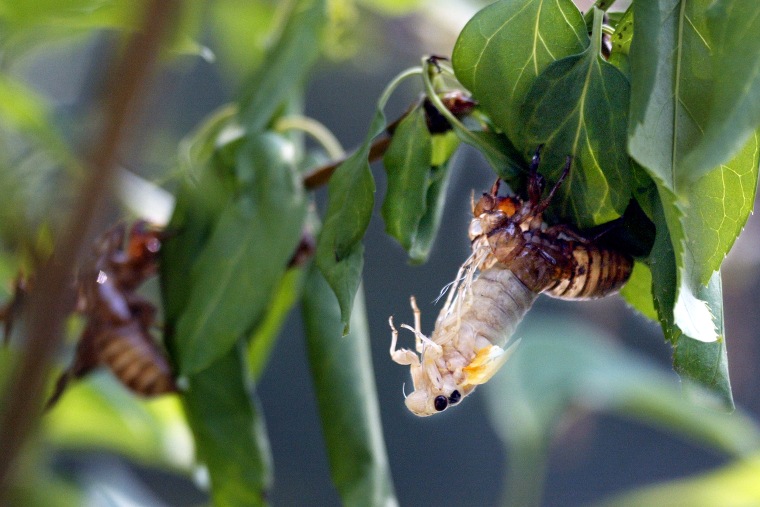Ready or not, the cicadas are back.
Across the eastern United States and parts of the Midwest, billions of cicadas are emerging from underground for the first time in 17 years to take part in a noisy, monthlong mating ritual.
Cicada sightings have already been reported in several states, including Virginia, Maryland and Georgia, but with warm temperatures expected for much of the East Coast over the next several days, the winged insects could be out in big numbers this week.
"It's such a unique experience because they really take over for a month or so," said John Cooley, an entomologist at the University of Connecticut. "There may be trillions of ants around, but most of the time you don't pay any attention to them. These are big, loud, funny-looking, charismatic and active insects, and you really can't ignore them."
The cicadas emerging now are periodical insects. They spend most of their lives underground feeding on tree roots, before tunneling to the surface to look for mates.
Six species of cicadas make their home across the eastern U.S. This year's emergence includes three species of insects that live on 17-year cycles — a group known as Brood X.
The cicadas typically emerge from underground once the soil reaches a temperature of around 64 degrees Fahrenheit, Cooley said.
"They count the seasonal cycles to get the right year and then they wait for an evening that isn't stormy or rainy, when the soil temperature is just right, and then out they come," he said.
Once the insects burrow to the surface, they shed their nymph exoskeletons and unfurl their wings. It subsequently takes several days for their adult skin to harden.
After that, the frenzy begins.
With mere weeks to find a mate and lay their eggs before they die, the cicadas are in a race against time. The insects emit a noisy, high-pitched mating song that can reach up to 100 decibels, roughly equivalent to a motorcycle or jackhammer, Cooley said.
But while the cicadas sound and look menacing — particularly with their blood-red eyes — they are not harmful to humans. Same goes for pets that may munch on the discarded cicada exoskeletons.
"They're not poisonous, but you wouldn't want your dog to gorge on them," Cooley said.
Researchers like Cooley are keen to study Brood X cicadas during this narrow window when they are active aboveground. Scientists are interested, for instance, in mapping their range and any behavioral changes between cycles.
"There were a lot of cicadas that made a mistake and came out four years early, in 2017," Cooley said. "We have those locations pinpointed and we want to see how many cicadas come out this time. Maybe they were areas that had an unusual abundance of cicadas, or maybe there was something odd going on."
And although the emergence of billions — even trillions — of noisy winged insects may fill some people with dread and anxiety, Cooley hopes people will enjoy and appreciate the experience.
"This is such an interesting and rare phenomenon," he said. "Enjoy it while it's out and remember that it's not going to happen for another 17 years."

